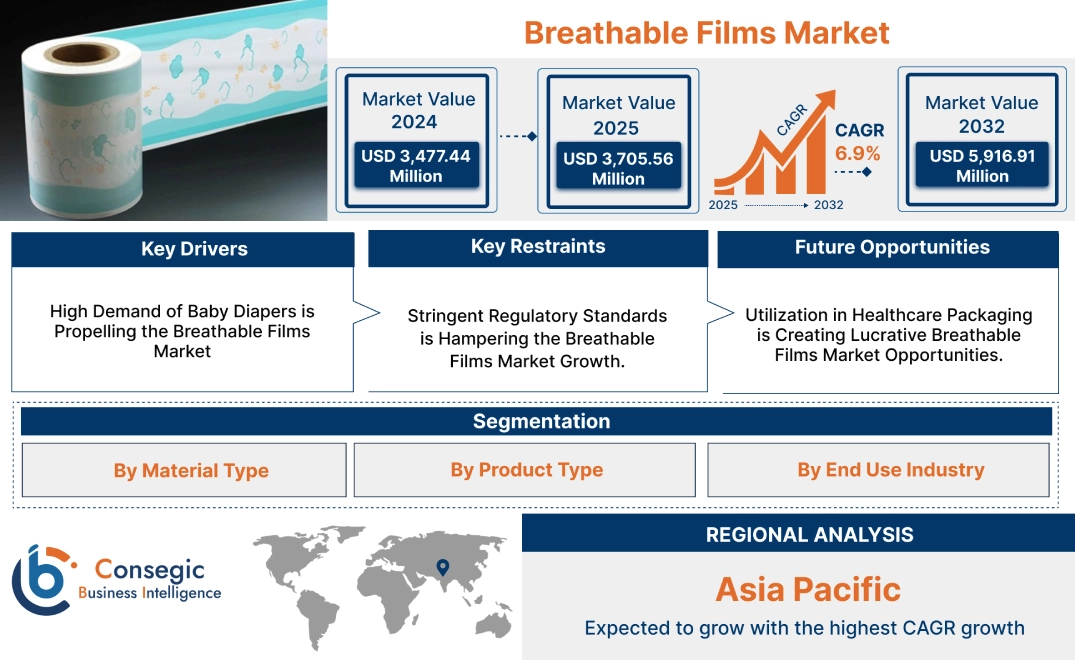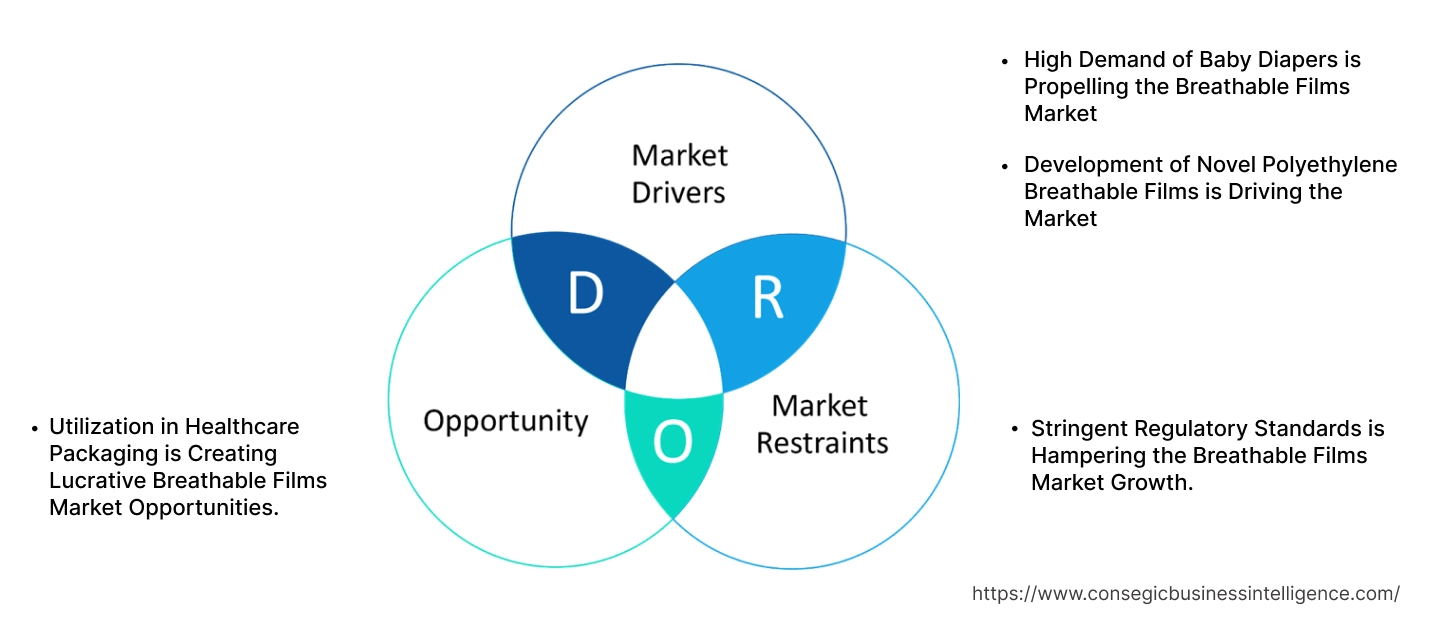- Summary
- Table Of Content
- Methodology
Breathable Films Market Size:
Breathable Films Market size is growing with a CAGR of 6.9% during the forecast period (2025-2032), and the market is projected to be valued at USD 5,916.91 Million by 2032 from USD 3,477.44 Million in 2024. Additionally, the market value for the 2025 attributes to USD 3,705.56 Million.
Breathable Films Market Scope & Overview:
Breathable films are special kind of sheets that are mainly polymer-based. These films allow gasses, vapor, and air to pass through them but restricts liquids. The films offer selective permeability property. This is because of molecule diffusion or microscopic pores present on the film. Along with selective permeability, the films also provide flexibility, and mechanical strength. The films are generally made from materials such as polyethylene (PE), polypropylene (PP), polyurethane (PU), polylactic acid (PLA), and others. The product type of these films includes microporous films, monolithic films, and others. The end use industries for these films are personal care & hygiene, medical, packaging, construction, textile, and others.
Key Drivers:
High Demand of Baby Diapers is Propelling the Breathable Films Market
Breathable films are the primary components used in modern diapers. These films ensure comfort and prevent irritation of the skin. They provide enhanced breathability and prevent liquid from leaking. This breathability is important to keep the diaper dry. This reduces diaper rash and other skin problems. Manufacturers are introducing novel diapers that offer high breathability.
For instance,
- In March 2024, Royale introduced a new diaper line. The diaper consists of a breathable outer layer. It allows moisture and vapor to escape which reduces the risk of irritation of skin. The film also provides a soft and comfortable finish.
Thus, the demand for baby diapers is propelling the breathable films market expansion.
Development of Novel Polyethylene Breathable Films is Driving the Market
Polyethylene is a widely used polymer for various applications. It provides enhanced properties such as flexibility, and easy processibility. Innovations in breathable polyethylene films improve breathability and barrier properties. They offer rigidity and improve the performance of the film.
For instance,
- In March 2021, Printpack introduced the Preserve line of breathable films. These films are laminated. The product is made from polyethylene. It increases the performance of the films and offers properties such as high rigidity and clarity.
Overall, novel films are developed that are made from polyethylene. These films are laminated which offer exceptional barrier properties. Thus, these factors are driving the breathable films market growth.
Key Restraints:
Stringent Regulatory Standards is Hampering the Breathable Films Market Growth.
Stringent regulatory standards are imposed by government bodies worldwide. They pose significant constraints in the breathable films market. These regulations are designed to protect the environment and public health. They increase production costs and slow down product development. Meeting stringent regulatory requirements often involves significant investments in testing, certification, and documentation. These costs cause a burden for smaller companies. Receiving regulatory approvals for new breathable film products or materials is generally a lengthy process. This delays the product launch and slows down innovation. It also discourages companies from investing in research and development. Additionally, evolving federal regulations increases the compliance and operating costs throughout the industry. Thus, these factors hinder the breathable films market expansion.
Future Opportunities :
Utilization in Healthcare Packaging is Creating Lucrative Breathable Films Market Opportunities.
Traditional healthcare packaging material are generally difficult to recycle. They are derived from non-renewable resources. Breathable films have the ability to protect medical devices and pharmaceuticals. Many of the films are made from recycled material and have renewable content. This makes them a sustainable option. For healthcare packaging these films provide a barrier against bacteria, viruses, moisture and other microorganisms. This ensures that the devices remain sterile until they are used.
For instance,
- In November 2024, DuPont introduced Tyvek with Renewable Attribution. It is an extension of the traditional Tyvek product line which consists of films that are breathable. The product is made using certified renewable content. It allows air and moisture vapor to pass through. They offer a superior microbial barrier for medical packaging.
Thus, the rise in the use of sustainable healthcare packaging is creating lucrative breathable films market opportunities.
Breathable Films Market Segmental Analysis :
By Material Type:
Based on material type, the market is categorized into polyethylene (PE), polypropylene (PP), polyurethane (PU), polylactic acid (PLA), and others.
Trends in Material Type:
- Adoption of polyurethane material for high performance applications is influencing the segment.
The polyethylene (PE) segment accounted for the largest market share in 2024.
- Polyethylene (PE) segment dominates the breathable films market trends.
- Polyethylene is a lightweight and flexible material.
- It has a microporous structure with tiny pores that allow air and moisture vapor to pass through while blocking liquids.
- PE also allows for the development of soft and comfortable films.
- Low-density polyethylene is commonly used as it provides good flexibility and sealability.
- Manufacturers are developing novel low-density polyethylene technologies that are useful for films that are breathable.
- For instance, in 2024, Univation Technologies, LLC announces the launch of its latest licensed technology platform which is a tubular high pressure PE process enabling production of low-density polyethylene (LDPE). This LDPE is used for the development of films that are breathable.
- Thus, as per the market analysis, these factors are influencing the segment.
The polyurethane (PU) segment is expected to grow at the fastest CAGR over the forecast period.
- Films made from polyurethane are made in such a way that they allow moisture and vapor to pass through.
- These films are known because of their elasticity and flexibility.
- This allows them to fit in with the body or substrate they are applied to. This provides comfort and a good fit for the body.
- Polyurethane films offer good tensile strength and tear resistance. This ensures that the film is able to withstand wear and tear in various applications.
- Polyurethane breathable films are used in diapers, sanitary napkins, and adult incontinence products to enhance comfort and prevent skin irritation.
- Thus, these factors are influencing the breathable films market demand in the coming years.
By Product Type:
Based on product type, the market is categorized into microporous films, monolithic films, and others.
Trends in Product Type:
- The rise in the trends for usage of microporous films in personal protective equipment (PPE) products.
The microporous films segment accounted for the largest market share in the year 2024 and is expected to grow at the fastest CAGR over the forecast period.
- The microporous films segment is dominating the breathable films market demand.
- Microporous films consist of various micropores. The pores are present in different sizes from nanometers to micrometers.
- These pores are carefully designed to allow the passage of water vapor and air molecules while blocking larger liquid molecules.
- The material of the film is mainly polymer, such as polyethylene or polypropylene, among others.
- For instance, in 2021, Favorite hub India introduced a microporous breathable film that is made from polyethylene. It has small pores which give it air permeability.
- Thus, the rise in the use of micropores is propelling the market at present and in the coming years.
By End-Use Industry:
Based on end use industry, the market is categorized into personal care & hygiene, medical, packaging, construction, textile, and others.
Trends in the End Use Industry:
- The rise in the trend for premium diapers is influencing the personal care and hygiene segment.
- Adoption of films for the weather-resistance barrier that allows the control of moisture is influencing the construction sector.
The personal care & hygiene segment accounted for the largest breathable films market share of 52.34% in the year 2024.
- Breathable films offer various properties such as functionality, and comfort. This makes them important for various products that are used for personal care and hygiene.
- These films are a key component in modern diapers, allowing air and moisture vapor to escape while preventing liquids from leaking.
- This breathability is essential for maintaining a dry and healthy environment within the diaper, reducing the risk of diaper rash and other skin irritations.
- In feminine hygiene products, these films allow for airflow and prevent moisture buildup, which contributes to comfort and reduces the risk of infections.
- Breathable films are made for specific requirements, such as varying levels of breathability, fluid resistance, and softness.
- This allows manufacturers to create products that cater to diverse needs.
- For instance, in 2024, Huggies launched its skin essentials training pants. The pants consist of films that are breathable and that help protect sensitive skin. It is designed for potty training and offers 100% leakproof protection.
- Thus, as per the market analysis, the use of comfortable personal care & hygiene products is influencing segment growth.
The packaging segment is expected to grow at the fastest CAGR over the forecast period.
- Breathable films when used for packaging provide various benefits.
- They enhance product freshness, extend shelf life, and improve the overall consumer experience.
- These films are crucial for packaging fruits and vegetables.
- They allow for the exchange of gases such as oxygen and carbon dioxide, regulating the atmosphere within the package.
- This helps to reduce spoilage, maintain freshness, and extend the shelf life of produce.
- These films prevent condensation from forming inside bakery packaging, which leads to sogginess and staleness. They help maintain the texture and quality of baked goods.
- For meals that are packaged while still hot, these films allow steam to escape. It prevents moisture buildup that leads to spoilage.
- Thus, based on the market analysis, these factors are driving the segment in the coming years.
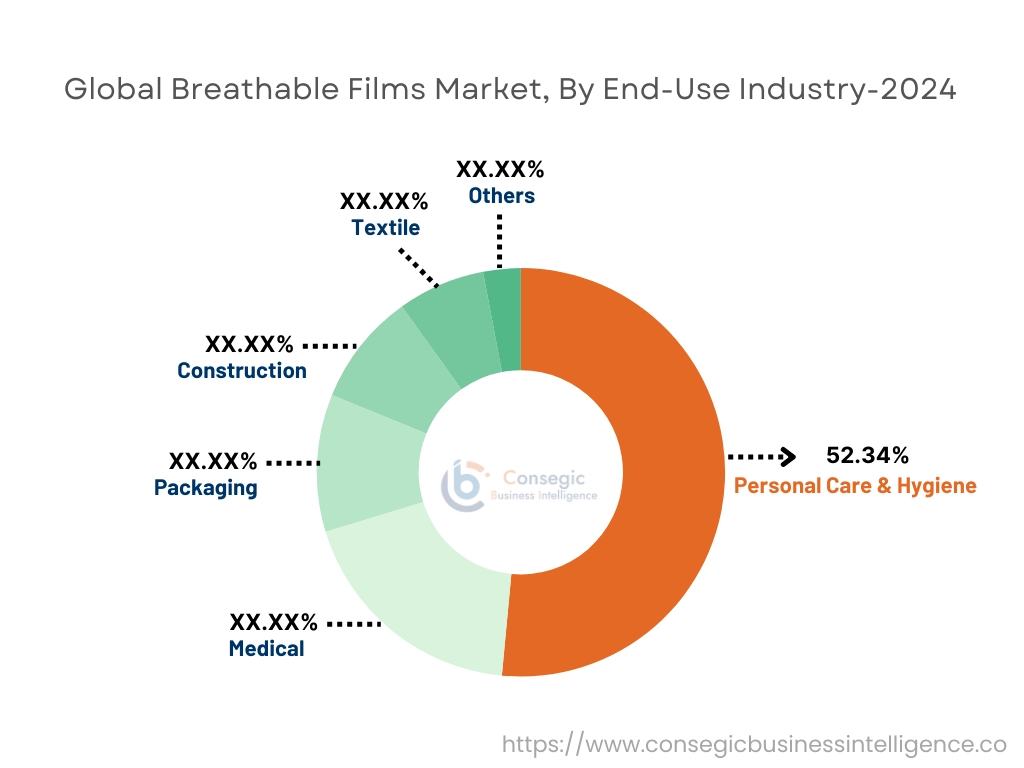
Regional Analysis:
The regional segment includes North America, Europe, Asia Pacific, the Middle East and Africa, and Latin America.
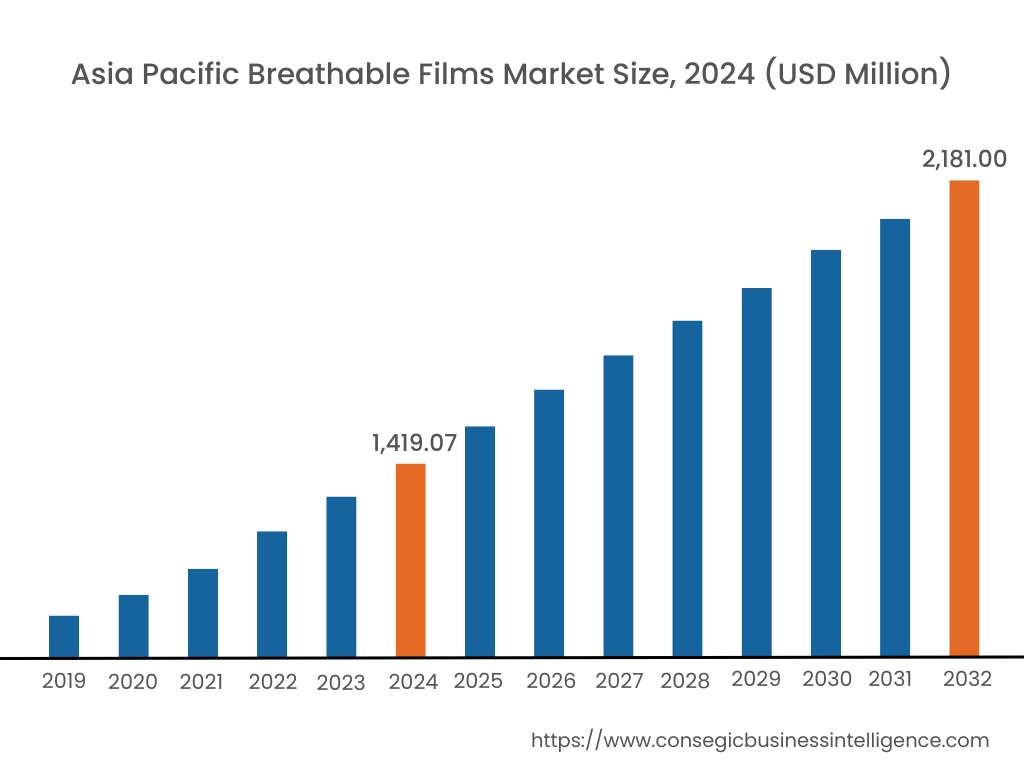
In 2024, Aisa Pacific accounted for the highest market share at 40.81% and was valued at USD 1,419.07 Million and is expected to reach USD 2,181.00 Million in 2032. In Asia Pacific, China accounted for the highest market share of 33.51% during the base year of 2024.
Asia Pacific dominates the global breathable films industry. This is mainly because of the rise in the requirements of personal care & hygiene products. These products generally include diapers and feminine care products. Additionally, there is a rise in awareness programs that explain the benefits of the use of sanitary napkins. Breathability is increasingly recognized as a crucial factor for comfort and hygiene. It is reducing the risk of skin irritation and infections. As women become more educated about menstrual hygiene, there is a rise in the use of sanitary napkins. These napkins incorporate breathable films.
For instance,
- For instance, according to the data published by India Environmental Portal, in 2024, states that that is a 25.3% rise in the use of sanitary napkins compared to the previous years in India.
Thus, as per the breathable films market analysis, these factors are influencing the growth of the market in this region
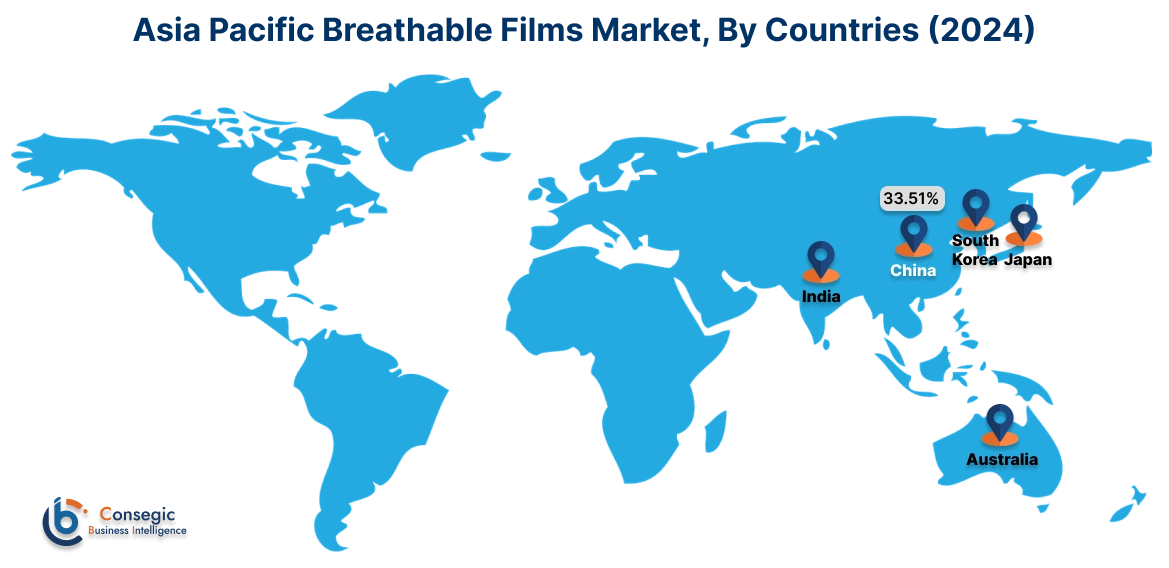
Europe is experiencing the fastest growth with a CAGR of 9.4% over the forecast period. The breathable films market trend across the region is mainly because of the rise in the packaging sector. Europe has a strong emphasis on fresh and high-quality food. These films play a main role in packaging fresh produce, bakery goods, and other food items. This helps to maintain freshness, extend shelf life, and prevent spoilage. Thus, as per the market analysis, the demand for high-quality food packaging drives the use of these films in the Europe region.
North America makes a high contribution to the breathable films market analysis. The medical sector in North America has very high standards for hygiene, safety, and performance. These films play a major role in meeting these requirements in various medical applications. These films are used in surgical drapes. They provide a barrier against fluids and pathogens while allowing for air circulation, ensuring the comfort and safety of medical professionals and patients. Additionally, they are used to package sterile medical devices and supplies. This maintains sterility and prevents contamination. Thus, these factors are driving the market trends in this region.
The Middle East and Africa (MEA) regions are witnessing growth in the market. This is mainly because of the rise in the textile sector. The textile sector in MEA is increasingly focusing on technical textiles. These are textiles designed for specific functional properties. These films are generally used in technical textiles to enhance their performance, such as in sportswear, protective clothing, and medical textiles. These films are used in sportswear and outdoor apparel to provide breathability and protection from the external factor. This contributes to the growth of the market in this region.
Latin America is an emerging region in the breathable films market share. This is because of the innovations in construction materials. Breathable films are used in construction as roofing membranes and wall wraps. These applications help to protect buildings from moisture damage. It also allows for the passage of air and water vapor. This prevents condensation from building up within walls and roofs. Thus, these factors are propelling the market in this region.
Top Key Players and Market Share Insights:
The global Breathable Films market is highly competitive with major players providing precise products to the national and international markets. Key players are adopting several strategies in research and development (R&D) and product innovation to hold a strong position in the global Breathable Films market. Key players in the Breathable Films industry include-
- Nitto Advanced Film Gronau GmbH (Germany)
- Arkema(France)
- Toray Industries (Japan)
- Mitsui Chemicals (Japan)
- Kimberly-Clark Worldwide, Inc. (United States)
- Tec Line (India)
- FORMOSA TAFFETA CO., LTD. (Taiwan)
- PrintPack (United States)
- Berry Global (United States)
Breathable Films Market Report Insights :
| Report Attributes | Report Details |
| Study Timeline | 2019-2032 |
| Market Size in 2032 | USD 5,916.91 Million |
| CAGR (2025-2032) | 6.9% |
| By Material Type |
|
| By Product Type |
|
| By End-Use Industry |
|
| By Region |
|
| Key Players |
|
| North America | U.S. Canada Mexico |
| Europe | U.K. Germany France Spain Italy Russia Benelux Rest of Europe |
| APAC | China South Korea Japan India Australia ASEAN Rest of Asia-Pacific |
| Middle East and Africa | GCC Turkey South Africa Rest of MEA |
| LATAM | Brazil Argentina Chile Rest of LATAM |
| Report Coverage |
|
Key Questions Answered in the Report
How big is the Breathable Films market? +
In 2024, the Breathable Films market is USD 3,477.44 Million.
Which is the fastest-growing region in the Breathable Films market? +
Europe is the fastest-growing region in the Breathable Films market.
What specific segmentation details are covered in the Breathable Films market? +
Material Type, Product Type, and End Use Industry segmentation details are covered in the Breathable Films market.
Who are the major players in the Breathable Films market? +
Nitto Advanced Film Gronau GmbH (Germany), Arkema (France), Tec Line (India) are some of the major players in the market.
